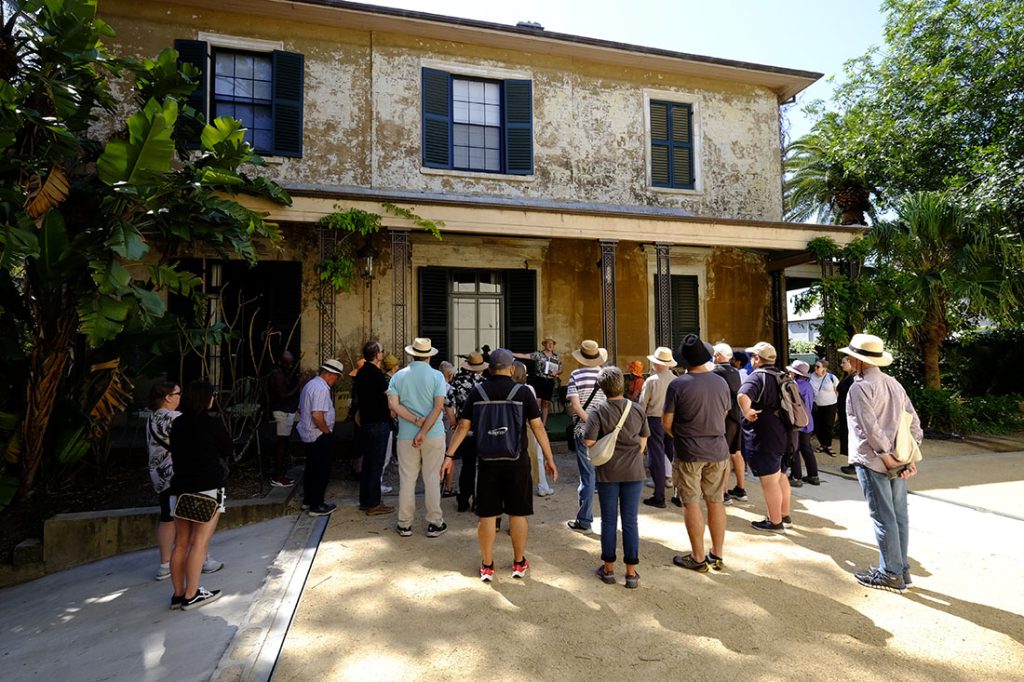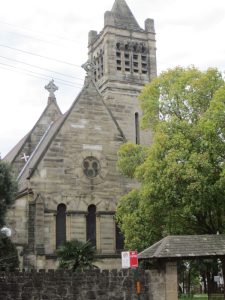By Robert Hannan, Bulletin 9/2023, November
Robert describes the Walk he conducted for the Society on Sunday 15 October.

The walk commenced on the corner of Darghan and Cardigan Streets within the Lyndhurst Conservation Area. After an acknowledgment of Country, an explanation was provided on what this country looked like before European arrival and how it was managed and lived on by the Wangal people of the Eora Nation for thousands of years.
A brief outline was provided of the church lands, the sale of 400 acres of the Glebe by the Anglican church in 1828 and the formation through that sale of residential blocks ranging from one to 90 acres, many with Parramatta River water frontage, views of the river, seas breezes, springs and good drainage. These blocks were well-suited for purchasers to build their generous marine villas with large pleasure grounds and outbuildings for stables and to accommodate servants.
The population of Sydney by 1830 was approximately 22,000. Sydney was quickly becoming crowded, dirty and undesirable, whereas Glebe was far enough removed to avoid these issues but still close enough for residents to commute to Sydney with relative ease.
I pointed out that poor planning and lack of understanding within the City of Sydney means that we are still losing items of heritage significance within Glebe. Such an example has been the recent removal of approximately 20 metres of the cobblestone road at Cardigan Street Reserve, heritage item no. 1676 in Sydney Local Environment Plan 2012.
We were welcomed by the owners of the 1837 Lyndhurst home and we provided an explanation of the history of this important John Verge-designed house, which was once a waterfront property. Using Lyndhurst as a case study, we explained that the cycle of boom times, depression, wars and – in hindsight – poor speculative investments, caused many of these large estates to be sold off and the land subdivided.
After World War I, these large inner-city homes faced many challenges. Former estate grounds, once the private domain of the villa owner, were surrounded by industrial developments and the resulting pollution. Intensive residential development on former estate land resulted in a substantial growth in the locality’s population. Further, it was increasingly difficult to find staff to maintain these estates. In time, large homes fell victim to the sledgehammer, were converted to flats or were re-purposed as boarding houses, orphanages or refuges for homeless people.,

We left Lyndhurst and walked to St John’s Anglican Church. I pointed out the rarity of this Edmund Blacket-designed Norman / Romanesque church; rare because it was a departure from Blacket’s usual gothic architectural style. Horbury Hunt, who worked with Blacket, supervised the building of St John’s and is known to have contributed to its design. We have been investigating records in the State Library of NSW which may provide more information about the contributions of Blacket and Hunt to the design of St John’s. In 1868, Horbury Hunt opened his own architectural practice and became renowned in his own right.
From St John’s Church we visited Foley Park and viewed the park’s interpretation of the original Hereford House, built in 1828 and demolished in the 1930s. A concrete band at ground level marks the outline of the original house, and is situated within a setting designed by City of Sydney’s landscape architects. We also viewed the heritage-listed Wireless House.
On departing Foley Park, we walked up Glebe Point Road pointing out sites of houses that once were, including The Wilderness, Kew Cottage, Pennington School, Rosebank and the Gothic or Swiss Cottages of which, sadly, only half remain. The remaining cottage, on the corner of Bridge Road and Glebe Point Road and hidden behind shops, now lacks its high gothic ornamentation. We wandered into Mansfield Street off Wigram Road and explained at length the Allen family’s 90-acre holding of the Toxteth Estate, which included eight houses for extended family and staff, a cricket oval, stables, and a private Wesleyan chapel.
Our next stop was over to the 1830s stone marine villa, Margaretta Cottage, where everyone was reminded to be quick and book their tickets for the Glebe Music Festival. Our last stop was in the grounds of the 1847 villa, Rothwell Lodge, on Ferry Road, for a photographic exhibition and refreshments. On the way there we were able to point out the sites of the now-demolished villas, Guildford Lodge, Maryville, Strathmore, Avona, Forsyth and Lyndoch. We discussed the crisis faced by Edmund Blacket’s own home, Bidura, the approved development and the eight-year battle to reduce the size and bulk of what was initially proposed.
The weather was perfect, the company was excellent, the last guests departed at 6.20 pm, and I believe a great day was had by all.
(Thanks to the owners of Lyndhurst, Margaretta Cottage and Rothwell Lodge for the privilege of seeing the interiors of these historical buildings. And thank you to Robert Hannan and Peter Crawshaw for the warm welcome to their home on this special event and for preserving this history in the (now out of print) publication Villas: Glebe and Forest Lodge pre-1870. This publication was produced for the Glebe Society’s 50th anniversary in 2019 and is available on the 50th anniversary website – Dorothy Davis, convenor, Glebe Walks)










There are no comments yet. Please leave yours.